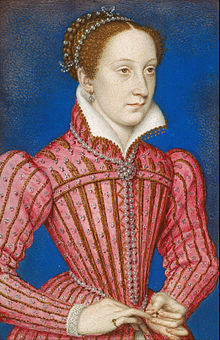
Back Maria I van Skotland Afrikaans Maria Scotta Cwēn ANG ماري ملكة إسكتلندا Arabic مارى ملكه اسكتلندا ARZ María I d'Escocia AST Mariya Stüart (kraliça) Azerbaijani مری ایستوارت AZB Maria, Reyna kan mga Eskoses BCL Марыя Сцюарт Byelorussian Марыя Ст’юарт BE-X-OLD
| Mary | |
|---|---|
 Portrait of Mary at about 17 years old, c. 1558–1560 | |
| Queen of Scotland | |
| Reign | 14 December 1542 – 24 July 1567 |
| Coronation | 9 September 1543 |
| Predecessor | James V |
| Successor | James VI |
| Regents | See list
|
| Queen consort of France | |
| Tenure | 10 July 1559 – 5 December 1560 |
| Born | 8 December 1542[1] Linlithgow Palace, Linlithgow, Scotland |
| Died | 8 February 1587 (aged 44)[2] Fotheringhay Castle, Northamptonshire, England |
| Burial | 30 July 1587 |
| Spouse | |
| Issue | James VI and I |
| House | Stuart |
| Father | James V of Scotland |
| Mother | Mary of Guise |
| Religion | Roman Catholicism |
| Signature |  |
Mary, Queen of Scots (8 December 1542 – 8 February 1587), also known as Mary Stuart[3] or Mary I of Scotland,[4] was Queen of Scotland from 14 December 1542 until her forced abdication in 1567.
The only surviving legitimate child of James V of Scotland, Mary was six days old when her father died and she inherited the throne. During her childhood, Scotland was governed by regents, first by the heir to the throne, James Hamilton, Earl of Arran, and then by her mother, Mary of Guise. In 1548, she was betrothed to Francis, the Dauphin of France, and was sent to be brought up in France, where she would be safe from invading English forces during the Rough Wooing. Mary married Francis in 1558, becoming queen consort of France from his accession in 1559 until his death in December 1560. Widowed, Mary returned to Scotland in August 1561. The tense religious and political climate following the Scottish Reformation that Mary encountered on her return to Scotland was further agitated by prominent Scots such as John Knox, who openly questioned whether her subjects had a duty to obey her. The early years of her personal rule were marked by pragmatism, tolerance, and moderation. She issued a proclamation accepting the religious settlement in Scotland as she had found it upon her return, retained advisers such as James Stewart, Earl of Moray (her illegitimate half-brother), and William Maitland of Lethington, and governed as the Catholic monarch of a Protestant kingdom.
Mary married her half-cousin, Henry Stuart, Lord Darnley, in 1565, and in 1566, they had a son, James. After Darnley orchestrated the murder of Mary's Italian secretary and close friend, David Rizzio, their marriage soured. In February 1567, Darnley's residence was destroyed by an explosion, and he was found murdered in the nearby garden. James Hepburn, 4th Earl of Bothwell, was generally believed to have orchestrated Darnley's death, but he was acquitted of the charge in April 1567, and the following month, he married Mary. Following an uprising against the couple, Mary was imprisoned in Lochleven Castle. On 24 July 1567, she was forced to abdicate in favour of her one-year-old son, James VI. After an unsuccessful attempt to regain the throne, she fled southward seeking the protection of her first cousin once removed, Elizabeth I of England.
As a great-granddaughter of Henry VII of England, Mary had once claimed Elizabeth's throne as her own and was considered the legitimate sovereign of England by many English Catholics, including participants in a rebellion known as the Rising of the North. Perceiving Mary as a threat, Elizabeth had her confined in various castles and manor houses in the interior of England. After eighteen-and-a-half years in captivity, Mary was found guilty of plotting to assassinate Elizabeth in 1586 and was beheaded the following year at Fotheringhay Castle. Mary's life and execution established her in popular culture as a romanticised historical character.
- ^ Bishop John Lesley said Mary was born on the 7th, but Mary and John Knox claimed the 8th, which was the feast day of the Immaculate Conception of the Virgin Mary (Fraser 1994, p. 13; Wormald 1988, p. 11).
- ^ While Catholic Europe switched to the New Style Gregorian calendar in the 1580s, England and Scotland retained the Old Style Julian calendar until 1752. In this article, dates before 1752 are Old Style, with the exception that years are assumed to start on 1 January rather than 25 March.
- ^ Also spelled as Marie and as Steuart or Stewart
- ^ "National Records of Scotland; Hall of Fame A-Z – Mary Queen of Scots". NRS. 31 May 2013. Retrieved 30 September 2022.
© MMXXIII Rich X Search. We shall prevail. All rights reserved. Rich X Search